How does a USB-C to USB 1.1 to DisplayPort adapter work?


USB-C to USB 1.1 to DisplayPort adapter is a versatile device that allows you to connect your USB-C enabled device to a DisplayPort monitor or projector. This adapter is particularly useful when you have a device with a USB-C port but need to connect it to a display that only supports DisplayPort. In this article, we will explore how a USB-C to USB 1.1 to DisplayPort adapter works and how it can benefit you.
Understanding USB-C and DisplayPort
Before we delve into the workings of the USB-C to USB 1.1 to DisplayPort adapter, let’s first understand what USB-C and DisplayPort are.
USB-C, also known as USB Type-C, is a relatively new standard for USB connectivity. It is a small, reversible connector that can transmit both power and data. USB-C ports are becoming increasingly common in modern devices such as laptops, smartphones, and tablets.
DisplayPort, on the other hand, is a digital display interface that allows you to connect a computer or other device to a monitor or projector. It supports high-resolution displays and can transmit both audio and video signals.
How does the USB-C to USB 1.1 to DisplayPort adapter work?
The USB-C to USB 1.1 to DisplayPort adapter acts as a bridge between your USB-C device and the DisplayPort monitor or projector. It converts the USB-C signal into a DisplayPort signal, allowing you to connect your device to the display.
Here is a step-by-step breakdown of how the adapter works:
1. The USB-C to USB 1.1 to DisplayPort adapter is connected to the USB-C port on your device.
2. The adapter recognizes the USB-C signal and converts it into a USB 1.1 signal.
3. The USB 1.1 signal is then converted into a DisplayPort signal by the adapter.
4. The DisplayPort signal is transmitted through the adapter’s DisplayPort output.
5. The DisplayPort output of the adapter is connected to the DisplayPort input on the monitor or projector.
6. The monitor or projector receives the DisplayPort signal and displays the content from your USB-C device.
Benefits of using a USB-C to USB 1.1 to DisplayPort adapter
Using a USB-C to USB 1.1 to DisplayPort adapter offers several benefits:
1. Compatibility: The adapter allows you to connect your USB-C device to a DisplayPort display, even if the display does not have a USB-C port. This is particularly useful when you have a newer device with a USB-C port and an older display with only a DisplayPort input.
2. High-quality display: DisplayPort supports high-resolution displays and can transmit both audio and video signals. By using the adapter, you can enjoy the full capabilities of your USB-C device on a DisplayPort monitor or projector.
3. Versatility: The USB-C to USB 1.1 to DisplayPort adapter is a versatile device that can be used with various USB-C devices, including laptops, smartphones, and tablets. It allows you to connect your device to different displays, making it ideal for presentations, gaming, or watching movies.
4. Easy setup: The adapter is easy to set up and use. Simply connect it to your USB-C device and the DisplayPort input on the monitor or projector, and you’re ready to go. There is no need for additional drivers or software installation.
Conclusion
In conclusion, a USB-C to USB 1.1 to DisplayPort adapter is a handy device that allows you to connect your USB-C enabled device to a DisplayPort monitor or projector. It works by converting the USB-C signal into a USB 1.1 signal and then into a DisplayPort signal. This adapter offers compatibility, high-quality display, versatility, and easy setup. Whether you need to connect your USB-C laptop to a DisplayPort monitor or your USB-C smartphone to a projector, the USB-C to USB 1.1 to DisplayPort adapter is a reliable solution.
Recent Posts
How do I create an engaging and informative online quiz or assessment?
Creating an engaging and informative online quiz or assessment can be a powerful tool for… Read More
What are the most effective methods for managing and reducing work-related stress in the hospitality industry?
Work-related stress is a common issue in the hospitality industry, where employees often face long… Read More
How can I improve my assertiveness and communication skills in a leadership position?
In a leadership position, assertiveness and effective communication skills are crucial for success. Being able… Read More
What are the key elements of a successful employee recognition and rewards program?
Employee recognition and rewards programs play a crucial role in motivating and engaging employees, as… Read More
How do I effectively manage and respond to customer feedback and reviews?
Customer feedback and online reviews play a crucial role in shaping a company's reputation and… Read More
What are the best strategies for effective time management as a stay-at-home parent?
Effective time management is crucial for stay-at-home parents who juggle multiple responsibilities on a daily… Read More